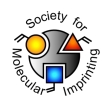Authors: Haq I, Mujahid A, Afzal A, Iqbal N, Bajwa SZ, Hussain T, Shehzad K, Ashraf H
Article Title: Developing imprinted polymer nanoparticles for the selective separation of antidiabetic drugs.
Publication date: 2015
Journal: Journal of Separation Science
Page numbers: n/a.
DOI: 10.1002/jssc.201500506
Abstract: In this study, new molecularly imprinted polymer nanoparticles are designed for selective recognition of different drugs used for the treatment of type 2 diabetes mellitus, i.e. sitagliptin and metformin. The sitagliptin- and metformin-imprinted polymer nanoparticles are synthesized by free-radical initiated polymerization of the functional monomers: methacrylic acid and methyl methacrylate; and the crosslinker: ethylene glycol dimethacrylate. The surface morphology of resultant molecularly imprinted polymer nanoparticles is studied by atomic force microscopy. Fourier transform infrared spectra of molecularly imprinted polymer nanoparticles suggest the presence of reversible, non-covalent interactions between the template and the polymer. The effect of pH on the rebinding of antidiabetic drugs with sitagliptin- and metformin-imprinted polymers is investigated to determine the optimal experimental conditions. The molecular recognition characteristics of the sitagliptin- and metformin-imprinted polymers for the respective drug targets are determined at low concentrations of sitagliptin (50-150 ppm) and metformin (5-100 ppm). In both cases, the molecularly imprinted polymer nanoparticles exhibit higher binding response compared to non-imprinted polymers. Furthermore, the molecularly imprinted polymers demonstrate high selectivity with fourfold higher responses toward imprinted drugs targets, respectively. Recycled molecularly imprinted polymer nanoparticles retain 90% of their drug-binding efficiency, which makes them suitable for successive analyses with significantly preserved recognition features. This article is protected by copyright. All rights reserved
Author keywords: Antidiabetic drugs, Metformin, Molecularly imprinted polymers, Sitagliptin



Join the Society for Molecular Imprinting

New items RSS feed
Sign-up for e-mail updates:
Choose between receiving an occasional newsletter or more frequent e-mail alerts.
Click here to go to the sign-up page.
Is your name elemental or peptidic? Enter your name and find out by clicking either of the buttons below!
Other products you may like:
 MIPdatabase
MIPdatabase









